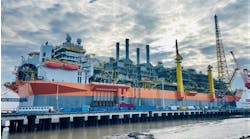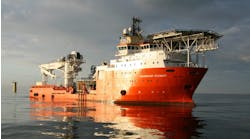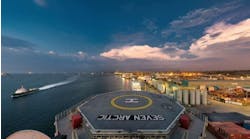The installation of two topside structures last year in the disputed Kuwaiti/Saudi Arabian offshore area was completed using Versabar’s Versatruss heavy-lift system. Following the test lift of the first deck, installation of both topsides was completed in 20 days. Within 10 days of completing the installation of the second deck, the heavy-lift system had been decommissioned and prepared for the 10,000-mi (16,093-km) return trip to Belle Chasse, Louisiana.
Versatruss heavy-lift system
The Versatruss heavy-lift system is a balanced, catamaran configuration that uses mechanical lifting similar to a derrick barge. The system connects to the outboard side of a deck using booms that attach to the centerline of barges with pinned connections. Lifting is achieved through the synchronous pay-in of the main hoist winches through lower horizontal blocks, pulling the two barges together. The pinned booms rotate to generate the lifting loads to raise (and lower) the decks.
The heavy-lift system has been used for deck lifts up to 6,500 tons (5,897 metric tons), for both the installation of new platforms and the decommissioning of old platforms.
The Versatruss system is not a conventional “fixed asset,” it is assembled on a project basis and disassembled following the completion of the work. This meant the system had to be assembled, commissioned, tested, certified, and prepared for 10,000 mi (16,093 km) open sea transportation in about four months.
Retrofitting lift steel to the decks
At the time of the installation contract award, fabrication of the two decks was 100% structurally complete, and 85% complete overall including facilities work. Both decks were designed for a single-hook derrick barge installation, though updated data found the deck weights exceeded the lift capacity of the contracted installation vessel. This changed strategy.
In conjunction with the design engineer, Versabar designed retrofit steel framing to provide the required attachment points and to insure proper distribution of the lift loads into the deck structure. The steel framing was designed to minimize clashes with all piping, cabling, and process equipment. Furnished padeye pins connected the system to the deck. All pins were proof load tested and certified prior to shipping from the US.
Long-range mobilization
The two Versatruss barges were mobilized from Belle Chasse, Louisiana, to the Arabian Gulf by way of the North Atlantic, Mediterranean Sea, Suez Canal, Red Sea, Gulf of Aden, and Indian Ocean. The 10,000-mi mobilization required approximately 60 days and was achieved in generally good weather, except for the portion of the tow through the top of the Indian Ocean during monsoon season. The barges and tugs experienced several days of sea states with significant wave heights of 15 ft (5 m) or more.
During passage through the Gulf of Aden the heavy-lift system was accompanied by armed guards and an armed escort vessel to deter the local pirates. Seventy days prior to passage of the system through this area, the client had a transport barge under mobilization to the topsides fabrication yard taken under pirate control and held for ransom. The Versatruss tow was achieved without incident. The same process was followed during the demobilization and the system safely completed the return to Belle Chasse .
Moving the topside over the jacket.
In-kingdom operations
The scope of installation services included the following:
- Re-commissioning of the Versatruss system following mobilization
- Versatruss hook-up to the topsides in sheltered waters
- A test lift of each of the decks at the port location
- Tow of Versatruss and the topsides to the installation location in trimaran formation (the deck on the main transport barge with the Versatruss barges attached)
- Installation of each of the topsides on the pre-installed jackets.
Jubail Commercial Port, 125 mi (201 km) southwest of the final installation site, was the primary base of operations for the commissioning, hook-up, and test lift operations. Local land cranes were used to support commissioning activities and local port tugs were used in addition to the Versatruss tugs for local barge maneuvering and handling.
A test lift of each of the decks allowed thorough verification of the lift sequence and a check for clashes and lift system trim. The test lift also fulfilled an additional function. Field geometry and location of other secondary structures on the deck transport barges (flare jackets, bridges) required the topsides to be relocated on each of the barges prior to installation. This was achieved by rotating each of the deck transport barges during the test lift process.
The trimaran tow procedure has been used on all topsides installations performed by Versatruss. This method is validated by theoretical analysis, model test, and field performance. During the trimaran tow, Versatruss supports approximately 60% of the weight of the topsides, with the remaining 40% supported by the main transportation barge.
This level of load distribution provides a stable and coherent system for towing. For this project, annual storm data was selected as the design criteria for the trimaran tow. During the installation of the first topside sea state conditions with a wave height equal to approximately 75% of the selected design conditions were encountered. The measured loads in the system during this tow showed dynamic loads to be well within predicted levels for those conditions (typical maximum dynamic amplification factor of 1.25 for internal lift system loads).
The total lift weights of the two topsides installed were 2,900 short tons (2,631 metric tons) and 3,600 short tons (3,266 metric tons). Versabar says the heavy-lift system previously installed topsides with lift weights of up to 6,500 short tons (5,897 metric tons) and the technology can be scaled for lifts of 20,000 tons (18,144 metric tons) or greater using the same general configuration.




